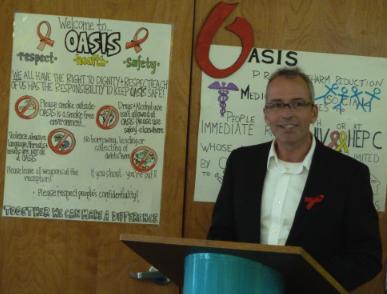Local advocates for successful harm-reduction programs are arguing that the federal omnibus crime bill places drug users at a higher risk of contracting diseases like HIV/AIDS and hepatitis C.
They say that Bill C-10, reintroduced last September by the Conservative Party, has more consequences than simply being “tough on crime.”
It’s a “regressive piece of legislation,” says Sandra Chu, senior policy analyst at the Canadian HIV/AIDS Legal Network, noting that infection rates are 10 times higher for HIV and 30 times higher for hepatitis C in prisons.
“The tough-on-crime bill is going to be tough on people who use drugs,” says Rob Boyd, director of the Oasis program at Sandy Hill Community Health Centre. “We need to use a health approach to the issue of addictions, rather than a criminal approach.”
Harm-reduction initiatives in Ottawa range from needle exchange programs to distributing clean crack pipes.
Health centres like Oasis offer numerous services, including a drop-in centre; health promotion events, such as movies about drug-use; and workshops on diseases. Oasis also has a medical clinic and an opiate substitution program, and staff members offer counselling and other resources to promote good health.
The goal of these programs is to reduce the rates of diseases that are common and easily spread by sharing needles or drug paraphernalia.
According to the city of Ottawa, HIV and hepatitis B and C infections in Ottawa in the late 1980s were said to grow to “epidemic proportions.”
A recent report by the Ottawa Integrated Drug and Addiction Strategy (OIDAS) initiative found that rates of infection for HIV and hepatitis C in the city are amongst the highest in Ontario. It noted that Ottawa has the second highest HIV infection rate in the country, after Vancouver.
It also found that there are between 3,000 and 5,000 people in Ottawa who inject drugs; 70 percent of this group also smokes crack cocaine.
A follow-up report was proposed in order to encourage the implementation of health programs, including harm-reduction initiatives.
“There is evidence globally on the effectiveness of harm-reduction programs,” says Chu. “They have been proven to lower the risk behaviours that are associated with HIV and hepatitis C transmission.”
However, Chu says there is no equivalent healthcare available in prisons.
“People who are getting incarcerated under mandatory minimum sentencing for drug-related offences . . . don’t have access to things like needle exchange programs, or there’s a waiting list for treatment,” Chu says. “If there’s needle and syringe programs in the community and we recognize their value, why are we denying them to people in prison?”
The Conservative government argues that harm-reduction programs are a safety concern. Representatives from the Conservative government declined to be interviewed for this story.
“Safer tattooing may be seen as coddling prisoners, or safer needle and syringe programs might be used as weapons,” Chu says.
Yet she says there are more than 60 prisons worldwide where these programs do exist, and studies have shown there has not been a single instance of a security threat.
Chu also notes there is no evidence that these programs encourage drug use, while there is evidence that they raise the numbers of people who seek treatment.
Harm-reduction programs are also under attack outside the criminal system.
In 2008, former mayor Larry O’Brien said needles should only be given to drug users who are in treatment programs.
However, the Ontario Ministry of Health, under the Health Protection and Promotion Act, said it would ensure that injection drug users could access clean drug paraphernalia and counselling or other information,
Currently, the city offers a few services in an effort to provide and collect resources like clean needles, including a mobile van and a needle drop box program. This program collected approximately 258,654 needles in 2010.
The city also has a Needle Hunter Program, which allows for the safe disposal of needles found in “priority neighbourhoods,” including the Byward Market, Centretown and Vanier. In 2010, this program collected 3,944 needles and 1,064 crack pipes.
On Jan 9, Project STEP (Support, Treatment, Education and Prevention) reached its fundraising goal of $2.25 million to build a residential drug treatment facility for youth.
Students for Sensible Drug Policy is a national advocacy organization that promotes harm reduction programs for young people. Caleb Chepesiuk, a member of the Ottawa chapter, says he became involved with the organization after city council cancelled the crack pipe exchange program.
Ottawa city staff collected 1,108 crack pipes in 2010, compared to 42 in 2006.
However, as of July 2007, Ottawa Public Health stopped distributing sterile crack pipes or safer inhalation equipment. This means that although the use of crack pipes went up significantly between 2006 and 2010, there is no longer access to clean equipment from the city.
Chepesiuk says attacks against harm-reduction programs have now been heightened at the national level, and the Conservative government has removed these programs from the National Drug Strategy.
“They also spent about $600,000 in legal costs trying to shut Insite down in Vancouver, which is absurd because they funded all this research that showed it worked,” Chepesiuk says. “Then they went ahead and wasted all this money in legal costs losing the court case.”
Ottawa Police Chief Vern White, who was recently appointed to the Senate, has also spoken against harm-reduction programs, which Chepesiuk says is a “big hurdle.”
Advocating for more severe punishments for drug users will discourage them from accessing healthcare services, says Chepesiuk.
Boyd says an accepting environment is key to combating drug use.
“We need to do more work with people while they’re actually using,” he says. “Someone may not be looking to stop, but they’re looking for something clean. This creates an environment where the stigma is removed for the individual, where they can breathe and be themselves and are more likely to look at the possibilities of change.”
Chepesiuk says harm-reduction programs save lives and money, lessening the strain on the healthcare system.
The OIDAS report states that “the financial cost for medications, liver transplants, healthcare and lost productivity is enormous.”
“Most people that don’t care about people,” Chepesiuk says, “at least care about money.”


 Why you can trust Xtra
Why you can trust Xtra


